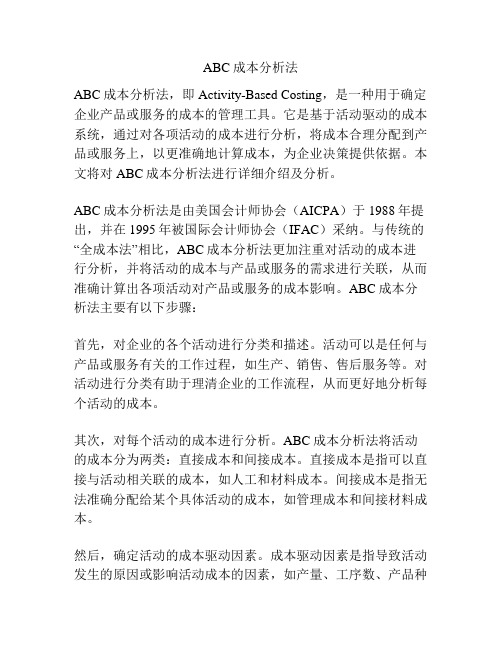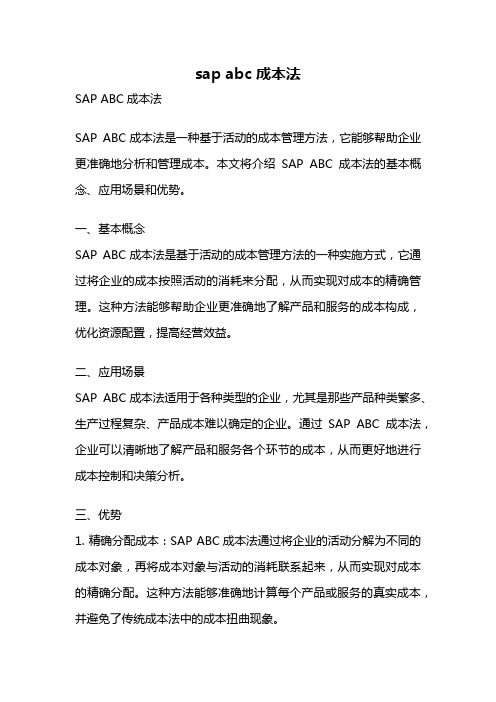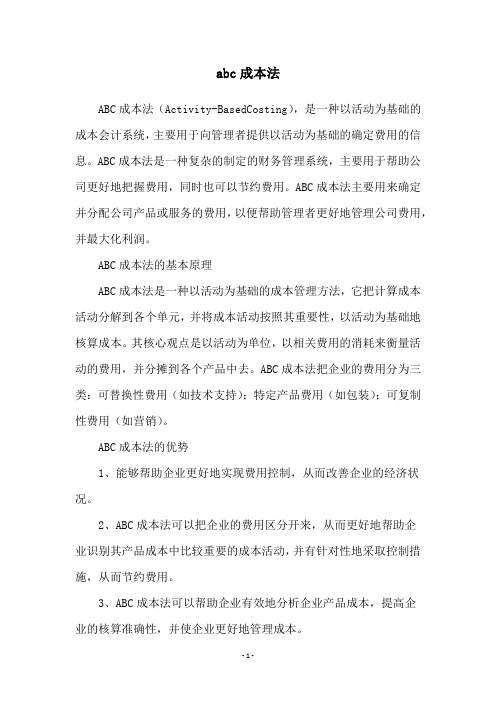ABC成本的优缺点
作业成本法(ABC)

缺点
ABC法需要收集大量的数据,并且相对其 他方法成本更高。
ABC法将成本分解到产品、服务和活动中,可帮助企业更准确地定位成本。
2 提高效率
ABC法可帮助企业更有效地使用资源,并更有效地管理成本激励措施。
3 决策支持
基于ABC法的成本分配,可以更好地了解生产瓶颈和利润中心,提供更优质的管理信息。
ABC法的缺点
复杂性 高成本 孤立应用
需要收集大量的数据,进行准确的成本计算,并 进行分解、分配和回归。
某医院
该医院使用ABC法对其提供的 医疗服务进行了详细的分析。 结果明确了哪些服务具有较高 的利润率,哪些服务利润率低, 以及如何进一步优化资源分配。
ABC法的结论和要点
1
优点
2
ABC法可帮助企业更准确地定位成本、提
高效率、提供更优质的管理信息。
3
结论
4
ABC法可以为企业提供深入的成本分析, 用于优化流程和提高生产效率。
简化
将产品成本分解为多个活动 成本,计算每个活动成本需 要的资源。
ABC法的基本原理
1
多元成本驱动因素
不同的产品、服务或成本单元有不同的驱动因素,这些因素导致了成本的不同。
2
固定成本分离
固定成本分离开来,使其不会被误认为是企业当前活动的负担。
3
成本分析
将成本作为有关成本对象的活动数量或水平的函数(例如:每一个销售订单),并进行成本分析。
ABC法的适用范围
生产密集型企业
ABC法可应用于对产品、生产程 序和生产成本进行细粒度分析的 生产密集型企业。
服务业
ABC法可用于对服务成本进行细 粒度分析,例如客户服务、资金 证券交易和投资银行。
abc管理法

abc管理法ABC管理法是一种系统性的管理方法,亦称为ABC成本管理法,它是一种以成本与效益为核心的管理策略,常被用于生产成本管理。
ABC管理法通过有效的管理成本控制和全面的财务分析,帮助企业更加精准地分配资源,实现资源最优化配置,提高企业的运行效率和核心竞争力。
I. ABC管理法的工作原理ABC管理法的核心是实现资源成本控制和效益最大化。
ABC管理法主要基于以下3个原则:1. 严格管理成本ABC管理法要求企业对每个区域、部门、产品、服务等进行精细化成本管理,通过有效的数字分析指导企业的日常经营管理。
在这一点上,企业需要了解每个部门或产品线所涉及的所有成本,包括直接成本和间接成本。
同时,ABC管理法根据成本的识别、分类和分配规则,帮助企业将成本分配给每个区域、部门、产品、服务等。
实现对资源成本及其效率的精细化控制。
2. 提高效率和质量ABC管理法最重要的是能够帮助企业全面认知各项业务和平台的开支,更加精准地理解每一个环节和部分,把握成本结构,分析整个流程和供应链,提高企业的效率和质量。
企业需要了解每个区域、部门、产品、服务等所带来的价值,分析哪些能够增加营业利润,哪些对企业持续发展有影响。
通过ABC管理法,企业能够全面地了解自己运作方式及成本,更加精细化的管理和提升整体效率,从而提升产品和服务的质量。
3. 拓展利润空间ABC管理法随时倡导企业管理者对业务和平台的开支进行精细化分析,了解每个区域、部门、产品、服务等的贡献和不足,分析营业利润,寻找增加营业利润突破口,从而拓展企业的利润空间。
通过充分利用ABC管理法,企业可以在细节处找到对企业愈发具备竞争力的切入点从而进一步提升企业的可持续性发展。
II. ABC管理法的具体步骤1. 识别和分类成本企业首先要了解其所涉及到的所有直接成本,包括材料成本、人工成本和直接费用;同事要对间接成本进行分类,便于精细化管理。
在这一步骤中,企业需要通过全面的分析来了解成本的每一个环节,为下一步的成本分配工作提供依据。
ABC成本分析法

ABC成本分析法ABC成本分析法,即Activity-Based Costing,是一种用于确定企业产品或服务的成本的管理工具。
它是基于活动驱动的成本系统,通过对各项活动的成本进行分析,将成本合理分配到产品或服务上,以更准确地计算成本,为企业决策提供依据。
本文将对ABC成本分析法进行详细介绍及分析。
ABC成本分析法是由美国会计师协会(AICPA)于1988年提出,并在1995年被国际会计师协会(IFAC)采纳。
与传统的“全成本法”相比,ABC成本分析法更加注重对活动的成本进行分析,并将活动的成本与产品或服务的需求进行关联,从而准确计算出各项活动对产品或服务的成本影响。
ABC成本分析法主要有以下步骤:首先,对企业的各个活动进行分类和描述。
活动可以是任何与产品或服务有关的工作过程,如生产、销售、售后服务等。
对活动进行分类有助于理清企业的工作流程,从而更好地分析每个活动的成本。
其次,对每个活动的成本进行分析。
ABC成本分析法将活动的成本分为两类:直接成本和间接成本。
直接成本是指可以直接与活动相关联的成本,如人工和材料成本。
间接成本是指无法准确分配给某个具体活动的成本,如管理成本和间接材料成本。
然后,确定活动的成本驱动因素。
成本驱动因素是指导致活动发生的原因或影响活动成本的因素,如产量、工序数、产品种类等。
通过确定成本驱动因素,可以更准确地将成本分配到各项活动上。
最后,将活动的成本分配到产品或服务上。
根据活动的成本和产品或服务对各个活动的需求程度,可以计算出每个活动对产品或服务的成本影响。
这样一来,就可以更准确地计算出产品或服务的成本,为企业的决策提供参考。
ABC成本分析法有以下的优点:首先,它可以更准确地计算产品或服务的成本。
传统的全成本法往往将成本均摊到产品或服务上,忽略了各项活动对成本的影响。
而ABC成本分析法通过对各项活动的成本进行分析,将成本合理分配到产品或服务上,可以更准确地计算出成本,帮助企业做出更合理的决策。
ABC作业成本制度

成本动因有两种形式: ①资源动因(resource driver),是指决定一项作业所耗费资源的因素,反映作业量与资源耗费间 的因果关系。 ②作业动因(activity driver)。是将作业中心的成本分配到产品或劳务、顾客等成本目标中的标准, 它也是将资源消耗与最终产出相沟通的中介。
基本概念 (4)成本库(Cost pool)
成本库是指作业所发生的成本的归集。在传统的成本会计中以部门进行各类制造费用的归集,而在 作业成本法中,将每一个作业中心所发生的成本或消耗的资源归集起来作为一个成本库。一个成本 库是由同质的成本动因组成,它对库内同质费用的耗费水平负有责任。
作业成本法的计算
作业成本法在计算产品成本时,将着眼点从传统的“产品”上转移到“作业”上,以作业为核算对象,首先根据作业 对资源的消耗情况将资源的成本分配到作业,再由作业依成本动因追踪到产品成本的形成和积累过程,由此而得出最 终产品成本。 根据作业成本计算的基本思想,ABC法的计算过程可归纳为以下几个步骤:
THANKS
我尊重版权并感谢每一位作者的辛苦付出与创作;如文章视频、图片等涉及 版权请第一时间联系,将根据提供的证明材料确认版权并立即删除!
ABC分析法的作用
由于成本动因和企业的业务 是变化的,为确保过去的数 据和分析结果能够仍然有效, ABC分析也需要定期进行修订。
仓储库存管理中的ABC分类法

仓储库存管理中的ABC分类法仓储管理对于任何一个企业来说都是至关重要的一项工作。
在仓储管理中,库存管理是其中的一个重要环节,而ABC分类法是一种常用的库存管理方法。
本文将介绍仓储库存管理中的ABC分类法的基本概念、应用步骤以及优缺点。
一、ABC分类法的基本概念ABC分类法是根据物资的重要性和使用频率将库存分为A、B、C 三类,以便更好地利用资源、控制库存成本。
ABC分类法依据的指标主要有物资的金额、使用频率和重要性等。
A类物资是指金额高、使用频率高、重要性大的物资。
这类物资一般是企业经营中的关键物资,对生产或销售具有直接影响。
对于A类物资,企业需要特别重视,确保其供应充足,以避免对生产或销售的影响。
B类物资是指金额适中、使用频率适中、重要性一般的物资。
这类物资虽然相对于A类物资来说不太重要,但仍然需要定期进行管理和采购,以保证生产和销售的正常进行。
C类物资是指金额低、使用频率低、重要性较小的物资。
这类物资一般是非常规性的物资,对生产或销售影响较小。
对于C类物资,企业可以采取更加灵活的管理措施,以降低成本和管理难度。
二、ABC分类法的应用步骤1. 数据收集与整理:首先,企业需要收集和整理物资的相关数据,包括物资的金额、使用频率和重要性等指标。
这些数据可以通过仓储管理系统或其他相关系统来获取。
2. 计算物资的重要性指数:根据收集到的数据,企业可以计算每个物资的重要性指数。
重要性指数的计算一般是根据物资金额的比例、使用频率的比例和重要性的评估等指标来确定的。
3. 分类划分:根据物资的重要性指数,将库存物资划分为A、B、C 三类。
一般而言,A类物资占总库存量的比例较小,但占用总库存金额的比例较高;C类物资占总库存量的比例较大,但占用总库存金额的比例较低。
4. 制定管理策略:根据不同类别的物资特点,制定相应的管理策略。
例如,对于A类物资,企业可以加强供应链管理,确保其供应充足;对于C类物资,可以采取库存定期清理或合并采购等措施。
作业成本法(ABC)-一种新的成本核算方式

作业成本法(ABC)-一种新的成本核算方式高顿网校友情提示,最新常州注册会计师协会网上公布相关作业成本法(ABC)-一种新的成本核算方式等内容总结如下:生产制造是企业的核心流程之一,成本核算则是影响到企业生产制造任务的完成水准的关键。
针对传统成本会计不适应新制造环境的局面,作业成本法(Activity-Based Costing,简称ABC)和基于ABC的作业成本管理(ABCM),在美、日和西欧诸国的企业,尤其是竞争激烈和人工成本很低的高新技术企业,得到了广泛的应用。
一、新制造环境冲击传统成本会计随着企业IT技术的运用,MRPII、ERP、CIM、JIT等系统应用范围不断扩大,企业新制造环境逐渐形成。
企业使用计算机管理信息系统来管理经营与生产,最大限度地发挥现有设备、资源、人、技术的作用,最大限度地产生企业经济效益,已成为制造业企业的一致选择。
从最早的物料需求计划MRP(Material Requirements Planning)、制造资源计划MRP II(Manufacturing Resource Planning)到近年出现的企业资源规划ERP(Enterprise Resource Planning)等,为越来越多的企业采用。
目前流行的MRPⅡ有助于管理当局进行及时、有效的投资与生产经营决策;ERP则是建立在信息技术基础上,以系统化的管理思想,为企业决策层及员工提供决策运行手段的管理平台。
不仅是MRP和ERP,促成新制造环境形成的新系统还包括:弹性制造系统(FMS)、电脑整合制造系统(CIM)和适时生产系统(JIT)等。
FMS是指使用机器人及电脑控制的材料处置系统,来结合各种独立的电脑程式机器工具进行生产,它有益于产品制造程序的弹性化。
CIM则是指以电脑为核心,结合电脑辅助设计、电脑辅助工程及电脑辅助制造系统等所有新科技的系统,以形成自动化的制造程序,实现工厂无人化管理,可减少人工成本、节省时间并提高工作效率。
sap abc成本法

sap abc成本法SAP ABC成本法SAP ABC成本法是一种基于活动的成本管理方法,它能够帮助企业更准确地分析和管理成本。
本文将介绍SAP ABC成本法的基本概念、应用场景和优势。
一、基本概念SAP ABC成本法是基于活动的成本管理方法的一种实施方式,它通过将企业的成本按照活动的消耗来分配,从而实现对成本的精确管理。
这种方法能够帮助企业更准确地了解产品和服务的成本构成,优化资源配置,提高经营效益。
二、应用场景SAP ABC成本法适用于各种类型的企业,尤其是那些产品种类繁多、生产过程复杂、产品成本难以确定的企业。
通过SAP ABC成本法,企业可以清晰地了解产品和服务各个环节的成本,从而更好地进行成本控制和决策分析。
三、优势1. 精确分配成本:SAP ABC成本法通过将企业的活动分解为不同的成本对象,再将成本对象与活动的消耗联系起来,从而实现对成本的精确分配。
这种方法能够准确地计算每个产品或服务的真实成本,并避免了传统成本法中的成本扭曲现象。
2. 改善资源配置:SAP ABC成本法能够帮助企业识别出哪些活动对成本的贡献最大,从而可以更好地进行资源配置。
通过合理安排资源,企业可以降低成本,提高效率,增强市场竞争力。
3. 决策分析支持:SAP ABC成本法提供了更多的成本维度和指标,可以帮助企业进行更全面的决策分析。
企业可以根据SAP ABC成本法的结果,更准确地评估产品的盈利能力,制定合理的定价策略,优化产品组合。
4. 激励机制建立:SAP ABC成本法能够识别出企业中的非增值活动,从而可以建立相应的激励机制。
通过激励机制,企业可以提高员工的工作积极性和效率,减少浪费,降低成本。
四、实施步骤1. 确定活动:首先,企业需要明确各个活动的定义和范围。
活动可以是生产过程中的某个环节,也可以是企业内部的某项管理活动。
2. 分配资源:然后,企业需要确定各个活动所消耗的资源,并将资源与活动关联起来。
这一步骤需要对企业的资源使用情况进行细致的调查和分析。
简述abc分类管理法

简述abc分类管理法ABC分类管理法是一种常用的物料管理方法,它通过对物料的重要性和使用频率进行分类,以便更好地控制库存和降低成本。
下面将从以下几个方面详细介绍ABC分类管理法。
一、ABC分类管理法的概念及作用ABC分类管理法是一种基于物料重要性及使用频率进行分类的方法,通常将物料分为三类:A类、B类和C类。
其中,A类物料重要性最高,使用频率最高;B类物料次之;C类物料则重要性和使用频率较低。
ABC分类管理法可以帮助企业更好地控制库存,并降低库存成本。
通过对不同类别物料的不同管理策略,可以实现库存优化、节约资金、提高效率等目标。
二、ABC分类管理法的具体步骤1. 数据收集:收集所有物料的相关数据,包括每个物料的名称、编号、单价、平均用量等信息。
2. 计算总消耗量:根据每个物料的平均用量和年度需求量计算出总消耗量。
3. 计算单位成本:根据单价计算出每个物料的单位成本。
4. 按照总消耗量排序:按照总消耗量从大到小排序,并计算出每个物料的累计消耗量和累计百分比。
5. 划分ABC类别:将物料按照累计百分比划分为A类、B类和C类。
6. 制定管理策略:根据不同类别物料的特点,制定不同的管理策略,以达到最优化的库存控制效果。
三、ABC分类管理法的优缺点1. 优点:(1)能够帮助企业更好地控制库存,降低库存成本;(2)能够提高物料使用效率,减少浪费;(3)能够优化采购计划,并减少采购成本;(4)能够提高企业生产效率,提高客户满意度。
2. 缺点:(1)需要大量数据支持,数据收集和处理较为繁琐;(2)无法考虑到物料的季节性需求或突发事件对库存的影响;(3)对于新产品或变动较大的产品难以进行分类管理。
四、ABC分类管理法的应用场景ABC分类管理法适用于各种类型的企业,特别是在以下场景下使用更为广泛:1. 生产型企业:适用于生产型企业中需要大量原材料和零部件的情况,可以帮助企业更好地控制库存和降低成本。
2. 零售企业:适用于零售企业中需要大量进货的情况,可以帮助企业更好地控制库存和优化采购计划。
abc成本法简单说明

abc成本法简单说明ABC成本法是一种常用的成本核算方法,它以活动为基础,将成本分配给不同的产品或服务,以便更准确地计算其成本。
在这篇文章中,我将简单介绍ABC成本法的原理和应用。
ABC成本法的全称是Activity-Based Costing,即基于活动的成本核算方法。
它与传统的成本核算方法不同,传统方法主要依靠直接人工和直接材料的成本进行分配,而ABC成本法更加注重活动的角色,通过识别和分配不同的活动成本,提供更精确的成本信息。
在ABC成本法中,首先需要明确不同的活动,并将其与产品或服务相关联。
活动可以是任何与产品或服务相关的工作或过程,例如生产、销售、分发等。
然后,对每个活动进行成本分析,确定其成本驱动因素。
成本驱动因素是影响活动成本的主要因素,可以是工时、订单数量、设备利用率等。
通过确定成本驱动因素,可以更准确地计算活动的成本。
接下来,根据活动成本和成本驱动因素,计算每个活动的成本驱动率。
成本驱动率是活动成本与成本驱动因素之间的关系,可以通过将活动成本除以成本驱动因素的总量得到。
成本驱动率可以用于将活动成本分配给不同的产品或服务。
在使用ABC成本法进行成本核算时,首先需要识别和分类不同的活动,然后确定成本驱动因素,并计算每个活动的成本驱动率。
接着,将活动成本按照其成本驱动率分配给不同的产品或服务。
通过这种方式,可以更准确地计算每个产品或服务的成本,帮助企业做出更明智的决策。
ABC成本法的应用范围广泛,特别适用于多样化产品或服务的企业。
传统的成本核算方法往往无法准确反映不同产品或服务的实际成本,而ABC成本法可以通过活动的精确分析和成本驱动率的计算,提供更准确的成本信息。
这对于企业的产品定价、投资决策和绩效评估等方面具有重要意义。
然而,ABC成本法也存在一些限制和挑战。
首先,实施ABC成本法需要大量的数据和分析工作,对企业来说可能需要投入较高的成本和人力资源。
其次,ABC成本法在一些特殊情况下可能不适用,例如生产过程简单、产品差异较小的情况下,传统的成本核算方法可能更加合适。
abc成本法

abc成本法
ABC成本法(Activity-BasedCosting),是一种以活动为基础的成本会计系统,主要用于向管理者提供以活动为基础的确定费用的信息。
ABC成本法是一种复杂的制定的财务管理系统,主要用于帮助公司更好地把握费用,同时也可以节约费用。
ABC成本法主要用来确定并分配公司产品或服务的费用,以便帮助管理者更好地管理公司费用,并最大化利润。
ABC成本法的基本原理
ABC成本法是一种以活动为基础的成本管理方法,它把计算成本活动分解到各个单元,并将成本活动按照其重要性,以活动为基础地核算成本。
其核心观点是以活动为单位,以相关费用的消耗来衡量活动的费用,并分摊到各个产品中去。
ABC成本法把企业的费用分为三类:可替换性费用(如技术支持);特定产品费用(如包装);可复制性费用(如营销)。
ABC成本法的优势
1、能够帮助企业更好地实现费用控制,从而改善企业的经济状况。
2、ABC成本法可以把企业的费用区分开来,从而更好地帮助企
业识别其产品成本中比较重要的成本活动,并有针对性地采取控制措施,从而节约费用。
3、ABC成本法可以帮助企业有效地分析企业产品成本,提高企
业的核算准确性,并使企业更好地管理成本。
ABC成本法的应用
ABC成本法在实践中得到了很多企业的应用,企业可以通过利用ABC成本法,更加细致地分解成本,从而更好地控制其产品成本,提高管理效率,同时也可以为企业提供更多有利于企业发展的信息。
以上是关于ABC成本法的介绍,希望本文介绍的ABC成本法能够为企业节省费用,提高企业的效率,同时保持企业的可持续发展。
作业成本法的优缺点

作业成本法的优缺点
作业成本法的优点:可以获得更为准确的产品和产品线成本(增加价值链),有助于改进成本控制,为战略管理提供信息支持。
作业成本法的缺点:开发和维护费用较高,不符合对外财务报告的需要,寻找成本动因比较困难;不利于管理控制。
作业成本法的缺点:部分作业的识别、划分、合并与认定,成本动因的选择以及成本动因计量方法的选择等均存在较大的主观性,操作较为复杂,开发和维护费用较高。
作业成本法的优点:可以获得更为准确的产品和产品线成本(增加价值链),有助于改
进成本控制,为战略管理提供信息支持。
A B C成本法又称作业成本分析法、作业成本计算法、作业成本
核算法。
现代管理学将A B C成本法定义为“基于活动的成本管理”。
A B C成本法是根据事物的经济、技术等方面的主要特
征,运用数理统计方法,进行统计、排列和分析,抓住主要矛盾,分清重点与一般,从而有区别地采取管理方式的一种定量
管理方法。
作业成本法的指导思想是:“成本对象消耗作业,作业消耗资源”。
作业成本法把直接成本和间接成本(包括期间费用)作为产品(服务)消耗作业的成本同等地对待,拓宽了成本的计算范围,使计算出来的产品(服务)成本更准确真实。
作业是成本计算的核心和基本对象,产品成本或服务成本是全部作业的成本总和,是实际耗用企业资源成本的终结。
作业成本法在精确成本信息,改善经营过程,为资源决策、产品
定价及组合决策提供完善的信息等方面,都受到了广泛的赞誉。
自20世纪90年代以来,世界上许多先进的公司已经实施作业成本法以改善原有的会计系统,增强企业的竞争力。
仓储成本计算的三种方式

仓储成本计算的三种方式仓储成本是一家企业在运营过程中需要考虑的重要问题。
仓储成本计算的准确性与合理性,将直接影响到企业的效益水平。
本文将介绍仓储成本计算的三种方式,供读者参考。
一、传统仓储成本计算法传统的仓储成本计算法包括固定成本和变动成本两种。
固定成本指存储在仓库内的物流设备、租金、人工等成本,这些成本无论存储的物品是否处于活跃状态都存在。
变动成本则是指取决于存储的物品的数量、品种和周期等变动的成本,如包装、装卸、保险等费用。
传统的仓储成本计算法有明显的缺陷:只考虑了对存储物品的基本要求,而未考虑更多因素的影响。
不仅如此,很多细节因素未予计算,仍需要补充其他细节的成本。
二、ABC成本法ABC成本法指的是根据活动开始计算成本。
它将每个环节的成本予以细分,并且计算时还可根据环节进行合理调配。
ABC成本法可以更准确地反映企业各项活动对成本的影响,使企业能够更好地掌握产品、客户和成本的关系。
ABC成本法的特点在于能够精确地分配每项活动的成本,并根据实际情况进行个别调整,使得成本更加准确。
三、作业成本法作业成本法就是按照业务流程或作业过程来计算成本。
它将生产过程和流程分解为多个作业阶段,每个阶段都是由一个或多个活动和资源完成的。
作业成本法通过对各个作业阶段进行{ 内部成本} 的细致处理,从而得到每个作业环节的实际成本。
另外,由于作业成本法将成本与生产流程产生的各个环节联系起来,因此,能够反映公司内部各项生产业务之间的联系,具有较高的实用性。
综上,不同的仓储成本计算方式各有优缺点。
企业可以根据自身实际情况,选择合适的方法,以更好地统计和归纳仓储成本,优化生产流程,并更好地提升产品的质量和企业的竞争力。
管理会计abc成本法

管理会计abc成本法
ABC成本法全称为Activity Based Costing(基于活动的成本核
算法),是一种管理会计方法。
它着眼于企业内部的各项活动,以及
这些活动对产品和服务成本的影响,从而更准确地计算产品和服务的
真实成本。
ABC成本法的核心在于“活动成本池”,将企业的所有成本按照
不同的活动进行分类,并对这些活动进行成本统计。
通过这些统计数据,将活动成本转化为成本对象(如产品或服务),最终得出成本对
象的真实成本。
相比传统的成本核算方法,ABC成本法有以下优势:
1. 更精确的成本计算。
ABC成本法更准确地反映了企业内部各项活动的成本,避免了传统成本核算中因过于简单粗略而造成的误差。
2. 更好的决策参考。
ABC成本法能够更精确地计算产品或服务的成本,从而更好地指导企业制定价格、产品策略等决策。
3. 更有效的成本控制。
ABC成本法将成本分解到各项活动中,便于企业管理层对各项活动的成本进行监控和管理,有效控制企业成本。
总之,ABC成本法是一种更精确、更科学的成本核算方法,已经
被越来越多的企业采用,成为了现代企业经营管理中的一个重要组成
部分。
举例说明作业成本法的优缺点

举例说明作业成本法的优缺点作业成本法(Activity-Based Costing,简称ABC)是一种在计算成本时使用的管理会计方法。
它通过识别和分析企业的活动及其成本,将成本分配给不同的产品或服务,从而较准确地计算出产品或服务的成本。
作业成本法起初是为了弥补传统成本会计方法的不足而提出的,该方法通过引入更多的成本驱动因素,提高了成本分配的准确性。
作业成本法在不同行业和组织中得到了广泛的应用,具有一定的优点和缺点。
首先,作业成本法的一个显著优点是提高了成本分配的准确性。
传统的成本会计方法主要以直接人工和直接材料为基础进行成本分配,忽视了其他间接成本的影响。
而作业成本法通过引入作业活动和成本驱动因素,将这些被忽视的成本分配给产品或服务。
例如,在制造业领域,作业成本法将生产线设备的维护费用、零件更换成本等间接成本与各个产品相关联,使得产品的成本计算更加准确。
这种准确性有助于企业管理者了解产品的实际成本,从而做出更科学的经营决策。
其次,作业成本法可以提高企业对活动效果的评估。
该法方法允许企业根据不同的活动来评估效果,并能识别出造成成本偏差的原因。
通过作业成本法,企业可以了解到不同的活动对产品或服务成本的影响程度,进而优化产品或服务的生产流程。
例如,在零售业中,作业成本法可以帮助企业分析不同销售渠道的效果,找出哪些渠道对成本的贡献更大,从而合理分配销售资源,提高销售效益。
此外,作业成本法还有助于企业的资源管理。
通过识别和分析企业的活动及其成本,企业可以更好地管理和优化资源的使用。
这是因为作业成本法可以帮助企业清楚地了解到哪些活动是浪费资源的,从而采取相应的措施来降低浪费。
例如,在服务行业中,作业成本法可以帮助企业识别出哪些客户群体需求较高,从而将资源有针对性地分配给这些群体,提高资源利用效率。
然而,作业成本法也存在一些局限和缺点。
首先,由于作业成本法需要收集大量的数据和信息,它的实施成本较高。
特别是对于一些中小企业来说,由于其自身规模较小,资源和人力相对有限,难以承担起作业成本法所需的大量数据收集和分析工作。
食品成本核算方法

食品成本核算方法食品成本核算是指对生产和销售食品的成本进行准确计算和分析的过程。
在食品行业中,成本核算对于企业的经营管理和决策具有重要的意义。
下面将详细介绍食品成本核算的方法。
1. 手工成本法:手工成本法是最简单直接的一种成本核算方法。
该方法主要通过将原材料的成本与劳动力成本相加来计算食品的成本。
在每一道菜品的制作过程中,记录所使用的原材料和劳动力的数量和成本,然后通过加总这些成本来计算整个菜品的成本。
手工成本法的优点是简单易用,不需要复杂的计算和数据处理。
但是,它的精度较低,容易出现误差。
此外,对于多种原材料和劳动力成本不同的复杂菜品,手工成本法的计算工作也较为繁琐。
2. 综合成本法:综合成本法是一种较为常用的食品成本核算方法。
该方法将各项直接和间接成本按一定比例分配到各个产品上,然后计算每个产品的成本。
综合成本法需要确定直接成本和间接成本的比例分配方法。
直接成本是指能够与特定产品直接相关的成本,例如原材料成本和直接人工成本等;间接成本是指无法直接与具体产品相关的成本,例如管理费用、房屋租赁费用等。
根据不同的企业和产品特性,可以选择不同的比例分配方法,如按产量、按重量、按面积等。
综合成本法的优点是能够按照不同的比例分配方法来进行成本核算,较为准确地反映出每个产品的成本。
但是,该方法需要建立合理的成本分配体系,需要花费较多的时间和精力进行成本分配和计算。
3. 标准成本法:标准成本法是一种基于标准化的成本核算方法。
该方法通过建立标准成本和实际成本之间的比较来计算食品的成本。
标准成本是指在一定生产条件下,制定的理论上合理的成本水平。
标准成本可以分为直接材料、直接人工和制造费用等方面。
实际成本是指实际发生的成本。
标准成本法的优点是能够及时发现和分析实际成本与标准成本之间的差异,帮助企业进行成本控制和管理。
但是,该方法需要对企业的生产过程进行深入了解和分析,并且需要建立合理的标准成本体系。
4. ABC成本法:ABC成本法是一种基于活动的成本核算方法,强调对企业各项活动的成本进行计量和分析。
评标价abc合成法

评标价abc合成法摘要:1.评标价abc 合成法简介2.评标价abc 合成法的具体操作步骤3.评标价abc 合成法的优缺点分析4.应用案例及效果展示正文:一、评标价abc 合成法简介评标价abc 合成法是一种在招标采购过程中,对投标单位的报价进行综合评价的方法。
该方法将投标单位的报价分为三个部分,即:A 部分成本价,B 部分利润,C 部分风险费用。
通过这种合成方式,可以更加客观、公正地对投标单位的报价进行评审,从而选出最优质的供应商。
二、评标价abc 合成法的具体操作步骤1.确定A 部分成本价:根据招标文件中的要求,结合行业标准和市场行情,对投标单位的成本进行预估,得出A 部分成本价。
2.确定B 部分利润:根据招标方的要求和行业惯例,对投标单位的利润进行合理设定,得出B 部分利润。
3.确定C 部分风险费用:根据招标项目的具体情况,综合考虑投标单位的资质、经验、服务等因素,设定C 部分风险费用。
4.计算合成价:将A、B、C 三部分费用相加,得出评标价abc 合成价。
三、评标价abc 合成法的优缺点分析优点:1.客观公正:通过合成价对投标单位的报价进行评价,减少了人为因素的干扰,提高了评审的客观性和公正性。
2.科学合理:将报价分为成本、利润和风险三部分,分别进行考虑,使得评价更加科学、合理。
3.有效激励:合理的利润设定可以激励投标单位提高自身竞争力,提高服务质量。
缺点:1.操作复杂:评标价abc 合成法需要对成本、利润和风险进行详细分析,操作过程较为复杂。
2.主观性强:虽然该方法减少了人为因素的干扰,但在确定A、B、C 三部分费用时,仍可能受到主观因素的影响。
四、应用案例及效果展示在某市政府采购项目中,采用了评标价abc 合成法对投标单位的报价进行评审。
通过该方法,招标方成功选出了价格合理、服务优质的供应商,为政府节约了大量采购成本。
作业成本法基本应用程序排序表

作业成本法基本应用程序排序表一、作业成本法简介作业成本法(Activity-Based Costing,简称ABC)是一种用于计算产品或服务成本的管理会计方法。
它通过将成本分配给产品或服务的各个环节,更准确地反映出产品或服务的实际成本。
作业成本法已经被广泛应用于不同行业和组织中。
二、作业成本法的基本原理作业成本法的基本原理是将企业的活动分解为若干个作业,并计算每个作业的成本。
作业是指企业的业务活动,可以是制造某个产品、提供某项服务或完成某个任务等。
作业成本法的核心是确定作业驱动因素,即影响作业成本的主要因素,如工时、设备使用量、材料使用量等。
通过分析作业驱动因素,可以更准确地确定各个作业的成本。
三、作业成本法的基本应用程序作业成本法的应用程序通常包括以下几个步骤:1. 识别作业首先需要识别企业的各项作业,例如生产某个产品的各个阶段、提供某项服务的各个环节等。
一般而言,作业的单位级别应该是可控制的,以方便后续成本计算和管理。
2. 确定作业驱动因素对于每个作业,需要确定影响其成本的主要因素。
这些因素可以是直接可观察的,如工时、设备使用量等;也可以是间接的,如专业知识要求、资质要求等。
确定作业驱动因素的关键是准确把握作业的本质和特点。
3. 收集成本信息收集每个作业的成本信息是作业成本法的关键步骤之一。
成本信息包括直接成本和间接成本。
直接成本是指可以直接归属于某个作业的成本,如直接劳动力成本、直接材料成本等;间接成本是指不能直接归属于某个作业的成本,如管理人员薪酬、设备折旧费用等。
4. 分配成本根据作业驱动因素,将间接成本分配给各个作业。
分配方法可以根据实际情况进行选择,常见的方法有驱动因素比例法、驱动因素层次法等。
分配成本的目的是更准确地反映出各个作业的实际成本,以便进行成本控制和决策分析。
5. 计算作业成本根据收集到的成本信息和分配的间接成本,计算每个作业的综合成本。
作业成本可以是实际发生的成本,也可以是预算成本。
评标价abc合成法

评标价abc合成法摘要:1.评标价abc 合成法的概述2.评标价abc 合成法的具体操作步骤3.评标价abc 合成法的优缺点分析4.评标价abc 合成法在实际应用中的案例分析正文:一、评标价abc 合成法的概述评标价abc 合成法是一种用于评估招标项目标书价格的科学方法,它主要通过分析标书价格的构成,综合评价各投标人的投标价格,以帮助招标方选择最具性价比的投标方案。
该方法以abc 合成法为基础,结合评标价的计算方式,有效提高了评标过程的科学性、公正性和准确性。
二、评标价abc 合成法的具体操作步骤1.对投标价格进行分解,将价格分为a、b、c 三个部分,其中a 部分为主要材料成本,b 部分为主要设备及安装费用,c 部分为施工及其他费用。
2.计算各部分的评标价。
评标价是指在原始价格基础上,经过一定的计算和调整后得到的价格。
计算公式为:评标价=原始价格×(1-调整系数)。
3.对各部分的评标价进行加权求和,得到最终的评标价。
权重可以根据项目的具体情况进行设定,如材料成本占总造价的比例、设备及安装费用占总造价的比例等。
4.根据最终的评标价,对各投标人的投标方案进行排序,选择最具性价比的投标方案。
三、评标价abc 合成法的优缺点分析优点:1.科学性:评标价abc 合成法通过对投标价格的深入分析,提高了评标过程的科学性。
2.公正性:该方法对所有投标人的投标价格进行统一的标准进行评价,保证了评标的公正性。
3.准确性:通过对投标价格的加权求和,使得评标结果更为准确。
缺点:1.操作复杂:评标价abc 合成法涉及到对投标价格的深入分析和计算,操作过程较为复杂。
2.主观性:权重的设定具有一定的主观性,可能影响评标结果的准确性。
四、评标价abc 合成法在实际应用中的案例分析在某基础设施建设项目的招标过程中,招标方采用了评标价abc 合成法进行评标。
经过对各投标人的投标价格进行分析和计算,最终选择了最具性价比的投标方案。
企业实施abc成本分摊方法

企业实施ABC成本分摊方法概述ABC(Activity-Based Costing,即基于活动的成本核算)是一种用于确定产品或服务成本的管理工具。
它通过将企业的活动划分为若干个活动成本池,并根据各个活动对产品或服务的消耗程度来分配成本,以更准确地计算产品或服务的成本。
在企业实施ABC成本分摊方法时,需要经过以下步骤:确定活动、收集数据、计算资源驱动因素、计算活动成本率、分配活动成本。
步骤一:确定活动在实施ABC成本分摊方法之前,首先需要对企业的主要活动进行分类和确定。
这些活动可以包括生产、销售、营销、研发等。
通过明确每个活动的目标和职责,可以帮助企业更好地理解其内部运作机制和资源消耗情况。
步骤二:收集数据收集数据是实施ABC成本分摊方法中非常重要的一步。
需要收集与每个活动相关的资源消耗和产出数据。
资源消耗可以包括人力资源、设备使用时间、材料使用量等;而产出数据可以包括产品数量、销售额等。
通过准确收集这些数据,可以为后续的成本分摊计算提供依据。
步骤三:计算资源驱动因素资源驱动因素是指衡量每个活动消耗资源的指标。
在实施ABC成本分摊方法时,需要根据收集到的数据计算出每个活动的资源驱动因素。
例如,对于生产活动来说,可以使用生产产品数量或生产工时作为资源驱动因素;对于销售活动来说,可以使用销售额或销售订单数量作为资源驱动因素。
步骤四:计算活动成本率活动成本率是指每个活动单位资源驱动因素所需的成本。
在实施ABC成本分摊方法时,需要将每个活动的总成本除以其对应的资源驱动因素,计算出各个活动的活动成本率。
这样可以更准确地了解每个活动所消耗的成本。
步骤五:分配活动成本在计算出各个活动的活动成本率之后,就可以开始进行成本分配了。
根据产品或服务所使用的各项活动及其对应的资源驱动因素,将每个产品或服务所需的各项活动成本按照其消耗程度进行分配。
通过这种方式,可以更精确地计算出每个产品或服务的成本,为企业提供决策依据。
优势和应用ABC成本分摊方法相比传统的直接成本法和间接成本法具有以下优势:1.更准确:ABC成本分摊方法能够更准确地反映产品或服务的实际成本,避免了传统方法中可能存在的成本偏差问题。
评标价abc合成法

评标价abc合成法摘要:一、引言二、评标价abc合成法的概念与原理三、评标价abc合成法的步骤1.确定评标价abc的类型2.收集数据3.建立模型4.计算合成价格四、评标价abc合成法的应用领域五、评标价abc合成法的优缺点分析六、总结正文:一、引言随着我国经济的快速发展,工程项目的招标投标活动日益频繁,评标价的合理性对于项目成本控制和招标投标结果具有重要意义。
评标价abc合成法作为一种有效的评标价计算方法,被广泛应用于工程造价领域。
本文将对评标价abc合成法进行详细介绍。
二、评标价abc合成法的概念与原理评标价abc合成法是一种基于abc分类法,通过对各项工程量指标进行加权平均计算,得到合成评标价的方法。
abc分类法是根据各项工程量指标的重要程度和波动程度进行分类,将工程量指标分为a、b、c三类。
其中,a类工程量指标重要程度高、波动程度大;b类工程量指标重要程度较高、波动程度较小;c类工程量指标重要程度较低、波动程度较小。
三、评标价abc合成法的步骤1.确定评标价abc的类型:根据项目的特点和需求,选择合适的abc分类法,对工程量指标进行分类。
2.收集数据:收集项目相关的工程量指标数据,包括各类工程量指标的数量、单价等。
3.建立模型:根据abc分类法和工程量指标数据,建立评标价abc合成模型。
4.计算合成价格:利用模型计算出各类工程量指标的合成价格,再根据各类工程量指标的权重计算总合成评标价。
四、评标价abc合成法的应用领域评标价abc合成法主要应用于工程项目的招标投标阶段,对投标单位的报价进行评价,以选择最优的承包商。
此外,该方法还可以用于项目成本控制、合同管理等方面。
五、评标价abc合成法的优缺点分析优点:该方法能够充分考虑各项工程量指标的重要程度和波动程度,使评标价更加合理;同时,通过建立模型计算合成价格,提高了评标价的计算效率。
缺点:评标价abc合成法对数据质量和模型的准确性要求较高,如果数据不准确或模型存在偏差,可能会导致合成评标价失真。
- 1、下载文档前请自行甄别文档内容的完整性,平台不提供额外的编辑、内容补充、找答案等附加服务。
- 2、"仅部分预览"的文档,不可在线预览部分如存在完整性等问题,可反馈申请退款(可完整预览的文档不适用该条件!)。
- 3、如文档侵犯您的权益,请联系客服反馈,我们会尽快为您处理(人工客服工作时间:9:00-18:30)。
The Success and Failure of Activity-Based Costing Systems Manivannan Senthil Velmurugan Faculty of Business and Law Multimedia University Melaka, Malaysia velmurugan@.my 3Multimedia University Melaka, Malaysia Phone: +606252-3740 Fax: +606-2318869 E-mail: velmurugan@.my AbstractThis paper studies the factors determining the success and failure of Activity-Based Costing Systems (ABC) implementation. Despite its perceived technical validity, ABC has not been widely adopted since its introduction in 1980s. For those organizations that have adopted ABC, the majority of them are using it tentatively. The perceived administrative and technical complexities are the main reasons of rejection of ABC. While ABC model is feasible for initial pilot studies, it is difficult and costly to scale to company-wide applications. Success or failure of ABC is found to be heavily influenced by a number of behavioral and organizational factors. The degree of importance of these behavioral and organizational factors to success of ABC is different at different stages of ABC implementation. Cultural differences play an important role in ABC implementation strategies. Approach to implement ABC should be tailored to specific cultural context.IntroductionConsiderable effort has been devoted to the development of more sophisticated costing system. The need to improve the accuracy of product costing information was driven by changes in the competitive landscape as well as increased global competition (Cooper 1988). The new competitive conditions challenged the validity of conventional costing systems. Cost accounting had traditionally allocated overhead to products or services using only one volume-sensitive driver, typically direct labor. For organization with highoverhead and a mix of products or services, using a single cost driver may distort cost estimate (Cooper and Kaplan 1988).Management accounting researchers have devoted considerable effort to addressing these limitations. Almost all of the attention has been devoted to studying activity based costing (ABC) systems. These systems emerged as the generic solution to product costing distortions and consequently as a means of improving competitiveness through more informed pricing and product mix decisions (Kaplan 1994). It has been claimed that activity-base costing (ABC) can provide improved information for strategic decisions involving product planning and cost management (Cooper 1988; Swenson 1995).While the literature promoting the benefits of ABC systems is intuitively appealing, evidence has indicated relatively low rate of adoption of ABC (Innes, Mitchell & Sinclair, 2000; Cotton, Jackman and Brown 2003). In addition, it is apparent that many organizations have not gained promised benefits (Innes et. al, 2000). It appears that while the technical characteristics of ABC are well understood, some organizations have difficulties in implementing the systems (Innes et. al, 2000; Shields 1995). The low rate of adoption of ABC and implementation failure has created considerable debate on its usefulness.A stream of literature has emerged recently examining the broader organizational contextual factors that influence both initial adoption and the extent of implementation of ABC (Shields 1995; Malmi 1997; Anderson et al 1999). Several authors have suggested that an important obstacle to successful implementation of ABC is a lack of attention to behavioral factors (Cooper 1992; Argyris and Kaplan 1994; Shields 1995; Foster and Swenson 1997; McGowan and Klammer 1997; Krumwiede 1998; Anderson and Young 1999; Anderson, Hesford and Young, 2002).Research problemAs competition increased, companies need more accurate estimates of product costs to set prices and to identify the most profitable products. Activity-Based Costing (ABC) was introduced as the solution to meet this challenge. Besides getting more accurate product costs for competitive pricing and product-mix decisions, it was reported that adopters of ABC are able to pinpoint opportunities to cut costs. In addition, companies can use ABC in routine planning and control. However, recent surveys indicated relatively low rate of adoption. In addition, many organizations have not gained promised benefits. From the literature review, it appears that the usefulness of ABC is being questioned. Effectively, the research problems are summarized as follows:∙No clear indication is noticed on reasons of low rate of adoption of ABC.∙No identification of common factors is made contributing to the successful adoption of ABC by those companies which have been using ABC for an extensive period of time.Objectives of the ResearchThe objectives of the research are:∙To identify reasons of low rate of adoption of ABC.∙To suggest ways of successful adoption of ABC by those companies which have been using ABC for an extensive period of time.JOURNAL OF PERFORMANCE MANAGEMENT4Survey of LiteratureLimitation of conventional costing method and the promises of Activity-Based Cost System (ABC) Miller and Vollman (1985) mentioned that overhead cost as a percentage of overall manufacturing cost have been rising steadily as direct labor costs to value added had declined. Data suggest that manufacturing overhead averages 35% of production in the United States and 26% in Japan. The drivers for overhead cost are transactions involve exchanges of the materials and information necessary to move production along but do not directly result in physical products. The transactions are classified as logistical, balancing, quality and change transactions. Logistical transactions involve order, execute and confirm the movement of materials from one location to another. Balancing transactions are activitieswhich ensure that the supplies of material, labor, and capacity are equal to demand. Quality transactions include quality control, indirect engineering, procurement, identification and communication of specifications, certification, and the development and recording of relevant data. Change transactions include update manufacturing information systems to accommodate changes in engineering designs, schedules, routings, standards, material specifications, and bill of material. There are three general approaches to managing overhead costs more effectively. Firstly, identify the necessary transaction and improve the method used to carry them out. Secondly, increase the stability of the manufacturing environment. The last approach is to rely on automation and systems integration. However, automation does not solve all problems. It may create some unless handled carefully. The authors presented various transactions as the cost drivers for the escalating manufacturing overhead cost and the importance of categorizing these costs. However, they did not elaborate on the method to categorize them.According to Kaplan (1988), cost systems need to address three different functions: inventory valuation for financial and tax statements, operational control and individual cost measurement. The demands of each function differ in term of reporting frequency, degree of allocation, nature of cost variability, system scope, and degree of objectivity. For inventory valuation, financial accounting principles do not require that assigned overhead costs be causally related to the demands of individual products on the enterprise‟s resources. So many companies use an aggregated, simplistic method for assigning overhead costs to products. Operational control system must provide accurate, timely feedback to managers on their performance. The system must correspond to the unit manager‟s level of responsibility, control for known variation in costs behavior, and minimize the incidence of cost allocations. The frequency of report should follow the cycle of the production process being measured. The cost control system should be based on a flexible budget that adjusts for costs that vary with fluctuations in short-run production activity. For product cost measurement, the system should realistically approximate the long-run demands each product makes on the organization‟s resources. All costs should be considered to be variable in the long-run according to the diversity and complexity of products. Besides traditional volume-related measures, thecost system must also measure setups, inspections, receipts, parts, vendors, and engineering change orders.A good product cost system should report expenses incurred across the organizatio n‟s entire value chain,The Success and Failure of Activity-Based Costing Systems5including factory resources to convert raw materials and purchased components to finished goods, marketing and sales, after sales services, engineering design, process improvement, purchasing, information systems, financial and cost analysis, and general administration. No single system can adequately answer the demands made by the diverse functions of cost systems. While companies can use one method to capture all transaction data, the processing of this information for diverse purposes and audiences demands separate, customized development. The current economics of information collection, processing, and reporting have made multiple cost systems possible. Managers can exploit new trends in distributed computing by developing decentralized systems for operational control and product costing. Even though the author mentioned that the product costs system should report expenses incurred across the organization‟s entire value chain, he did not elaborate the method to allocate these expen ses.Cooper and Kaplan (1988) highlighted that typical cost accounting system which allocates factory and corporate overhead by burden rates on direct labor resulted in distorted cost information. Expensesfrom factory support operations, marketing, distribution, engineering, and other overhead functions have increased significantly with increasing product lines and marketing channels. An alternative approach, activity-based costing is presented. The theory for this approach is that all activities exist to support the production and delivery of goods and services. All factory and corporate support costs are divisible and can be traced to individual products. Two types of cost should be excluded from activity-based costing, e.g. the costs of excess capacity and R&D cost for entirely new products. The R&D cost should be split into two categories: those that relate to improvement and modification of existing products and those that relate to entirely new products. The first category should be traced to the products that will benefit from the development effort. The second category should be treated as investment in the future. Activity-based cost system can lead to radically different evaluations of product costs and profitability than more simplistic approaches. Information generated by an activity-based cost system can encourage companies to redesign products to use more common parts, change new process technologies evaluation, streamlining the manufacturing process to reduce setup times, rationalizing plant layout to lower material handling costs,and improving quality to reduce postproduction inspections. Activity-based costing is designed to provide more accurate information about production and support activities and product costs so that managementcan focus its attention on the products and processes with the most leverage for increasing profits. The authors highlighted the benefits of using ABC but did not mention the cost of implementation and challenges that need to be overcome.Cooper and Kaplan (1991) stated that gross numbers on corporate financial statements would not help managers improve future financial performance. To improve profit, managers need to understand patterns of resource consumption at the micro level. Different products, brands, customers, and distribution channels consume company's resources differently. ABC analysis illuminates activities that are associated with that part of the business and links those activities to the generation of revenues and the consumption of resources. By highlighting those relationships, ABC helps managers understand precisely where to take actions that will drive profits. Managers should take two types of actions after an ABC analysis. First, theyJOURNAL OF PERFORMANCE MANAGEMENT6should raise prices for products that make heavy demands on support resources and lower prices to more competitive levels for the high-volume products that had been subsidizing the others. Second, and more important, managers should search for ways to reduce resource consumption. This requires either decreasing the number of times activities are performed for the same output, such as by changing product and customer mix, or reducing the resources consumed to produce and serve the existing mix of productsand customers. This might mean designing products with fewer and more common parts, or customizing products at the last possible production stage, or implementing continuous-improvement programs to enhance quality, reduce setup times, and improve factory layouts, or adopting information technology to facilitate the processing of batches, products, and customer orders. When fewer of their resources are being demanded, managers must either get rid of the freed-up resources or redeploy them for additional output. If managers fail to follow up any reductions in the demands on organizational resources, improvements will create excess capacity, not increased profits. The authors presented the usefulness of ABC to increase profitability but did not discuss the challenges to implement it successfully.Cooper and Kaplan (1992) stated that activity-based cost systems contain two important insights. First, the activities performed by many resources are not demanded in proportion to the total volume ofunits produced. The demands arise from the diversity and complexity of the product and customer mix. Second, activity-based cost systems are not models of how expenses or spending vary in the short-run.ABC systems estimate the costs of resources used to perform activities for various outputs. During any given period, the production of products and services, and their marketing, sale and delivery to customers, create a demand for organizational activities. The quantity of each activity supplied to outputs is estimatedby activity cost drivers such as the number of setup hours, number of purchase orders processed, number of receipts, number of direct labor and machine hours, and number of parts maintained. By summing acrossthe costs of all resources supplied to perform activities for individual outputs, the ABC model estimates the costs of resources used during the period by all the organization's outputs. Activity-based systems model how activity usage varies with the demands made for these activities. If activity usage exceeds the quantity available from existing resource supply, then higher spending to increase the supply of resources will likely soon occur. If, however, activity usage is below available supply, spending or the expenses of resourceswill not decrease automatically. Management, to obtain higher profits, must take conscious actions either to use the available capacity to support a higher volume of business or to reduce spending on resources by eliminating the unused capacity. Costs and profits are fixed only if management takes no action, and leaves the unused capacity undisturbed. Management behavior, not cost behavior, determines whether reductionsin resource demands become translated into higher profits. The authors presented clearly the importance of ABC but did not elaborate the efforts needed to implement ABC systems.McKenzie, J. (1999) stated that while standard costing techniques used by most companies is easyto understand and apply, with the exception of factory or operational direct costs, they fail to allocate other business costs on a realistic basis. These other business costs include manufacturing indirect, sales andThe Success and Failure of Activity-Based Costing Systems7marketing, customer service, R&D, purchasing, supply, IT support and personnel. Standard costing allocates these on an arbitrary basis, using direct labor hours, square meters, number of units produced or sold, number of customers etc. In a non-manufacturing or service business, the problem is understandably even more acute. ABC takes a rational approach to product, service and customer costing, identifying what major activities are performed in each function across the business. An assessment is made of how much company resource is actually consumed by each activity. These are allocated to activities using appropriate methods dependent on the type of resource to be allocated. Many companies using ABC have found that highly prized customers are found to be amongst the most unprofitable. Some products thought to be highly profitable turn out to be the complete opposite when all the hidden costs are allocated. ABC produces far more accurate and rational management information on which crucial product, customer and service decisions can be taken. It is being used as part of product lifecycle management by tracking total costs over time and for costing key business processes such as new product or service introduction. It is used for establishing economic order quantities in purchasing by costing the full and true acquisition cost and for establishing minimum order values or quantities to be applied to customer orders. In short, the potential applications of ABC in the management decision process are many. The introduction of ABC can be daunting to organizations, especially the on-going maintenance. However, a number of PC-based ABC software tools have been developed to take away much of the pain in data capture, modeling and reporting. Also, sufficient implementations have resulted in the accumulation of sufficient ABC experience to avoidthe bigger pitfalls. While it is true that ABC can produce much more accurate information, the author may have under stated the challenges organizations have to overcome to implement and sustain ABC.Horngren, Harrison and Bamber (2005) stated that ABC is one of the several methods managers use to deliver value to the customer at a profit. Organizations use refined ABC costing systems because simple systems can assign costs inequitably. As competition increased, managers need more accurate estimates of product costs to set prices and to identify the most profitable products. ABC focuses on activities as the fundamental cost objects. The costs of those activities become building blocks for compiling the indirect costs of products, services, and customers. Each activity‟s indirect cost has its own cost driver. After implementing ABC, companies often realize they were over costing high-volume products and under costing low-volume products. Most companies adopt ABC to get more accurate product costs for pricing and product-mix decisions. But they often reap even greater benefits by using ABC to pinpoint opportunities to cut costs. In addition, companies can use ABC in routine planning and control. However, ABC must past the cost-benefit test to be adopted widely by companies. Benefits of adopting ABC are higher for companies in competitive markets; that produce many different products that use different amount of resources; have high indirect costs; that produce high volumes of some products andlow volumes of other products. The costs of adopting ABC are lower when the company has accountingand information system expertise to develop and sustain the system, and information technology like bar coding, optical scanning, or …data warehouse‟ systems to record and compile cost driver data. A recent survey has shown that 89% of the companies using ABC data say it was worth the cost. Adoption is on theJOURNAL OF PERFORMANCE MANAGEMENT8rise but ABC is not a cure-all. ABC will not reduce cost, it will only help companies understand costs betterto know what to correct. The authors stated that adoption of ABC is on the rise but did not elaborate on the growth rate and source of data for verification.Surveys of Implementation of ABCSwenson (1995) carried out a study to determine the benefit of ABC to manufacturing industry.The results show that all respondents reported an improvement in at least one dimension of their cost management systems following the implementation of ABC. They reported the most improvement for product costing and cost control efforts, but they also reported significant improvements in their performance measurement systems. ABC was also used to improve the accuracy of customer cost information, which supports customer profitability analysis. Twenty-four percent of the sampled firms use ABC for product sourcing decisions. Seventy-two percent of the sampled firms use ABC to support pricing and product mix decisions. Managers at firms which secure business through a bidding process stood out as the most satisfied users of ABC information for pricing decisions. ABC information was used most frequently to support process improvement. Forty-eight percent of respondents use ABC to support product design decisions. Only seven of the twenty-five sampled firms had incorporated ABC into their performance measurement systems at the time of the interviews. Yet many respondents view performance measurement as the "final output" of their ABC implementation efforts. This study found broad support for activity-based cost management systems among the sampled firms. The applications of ABC techniques were quite varied, and the participants represented a wide variety of industries, yet each firm appeared to benefit from at least one dimension of its ABC system. Following the implementation of ABC, they reported higher levels of satisfaction with their cost management systems. The participants also provided specific examples of how they used the activity-based cost information to support decision making. Future studies should include firms which have attempted to implement ABC but failed. These studies can thenlook for differences in firm characteristics, or other factors such as management support or commitment, to explain success or failure with activity-based costing.Survey carried out by Trond Bjornenak (1997) in Norway indicated that adopters of ABC have a higher overhead cost as a percentage of total cost than non-adopters, which is consistent with the argument presented by Cooper. Even though the survey results indicate that the adopters have more refined systems than non-adopters, there is no difference in allocation bases. This is not in aligned to the claims by ABC literature that conventional costing systems employ a limited number of cost pools and allocation bases (Cooper, 1988), whereas ABC typically involves a greater number of cost pools and bases. The survey results indicate that adopters have a higher number of product variants. However, the results show that the non-adopters make significantly more customized products than adopters. Product diversity is argued to be the major factor causing product cost distortions in conventional costing systems (Cooper, 1988). Highly customized production normally means high product diversity, especially complexity diversity, material diversity and set-up diversity. Customized production also normally increases the cost of developing aThe Success and Failure of Activity-Based Costing Systems9costing system. This may explain the findings. One possible interpretation of the result is that ABC is adopted by companies with a high number of semi-standardized products. The survey results indicate that non-adopters of ABC have a higher number of competitors and a higher export rate. This is not consistent with the assumption that higher competition means higher adoption rates. The author pointed out that adoption of ABC is related to market rhetoric on ABC and the role of consulting firms in diffusing ABC.All firms that had implemented ABC or currently were implementing ABC had used assistance from consultants. In addition, the source of ABC information seems to effect the adoption decision. Larger companies have a larger network of communication channels and the necessary infrastructure for adopting ABC. Although the author presented the potential reasons on the differences between the results of the survey and claims by ABC literature, he did not have data to verify his claims.Gosselin (1997) examines the effect of strategic posture and organizational structure on the adoption and implementation of general forms of activity management (AM) by a sample of strategic business units (SBUs) in Canadian manufacturing firms. AM is divided into three levels: activity analysis (AA), activity cost analysis (ACA) and ABC. AA is the initial level while ABC is the final and most refined one. ABC subsumes ACA and AA. AA is a prerequisite to performing an ACA. The results showthat strategy influences the extent to which SBUs adopt an AM approach. As expected, organizations with high vertical differentiation are positively associated with the adoption of ABC over other form of AM. Furthermore, centralization and formalization are associated with organizations that actually implementABC after adopting it. The results show that prospectors adopt ABC approach more frequently than analyzers and defenders. Furthermore, prospectors tend to be larger organizations. Analyzers also tend to implement AM approaches more than defenders. These results are consistent with the hypothesis that competitive strategy influences managers‟ decision to adopt an AM approach. SBUs with higher number of hierarchical levels are more likely to adopt ABC. The selection of an administrative innovation like ABC is facilitated in SBUs that have a higher level of vertical differentiation because this type of innovation is much more formal. Centralized and formal SBUs that adopted ABC tended to implement ABC while decentralized and informal organizations tended to stop at the AA or ACA level or finally decided to stopto implement an AM approach. The results show that when mechanistic SBUs make the decision to adoptan innovation such as ABC, they carry through with the overall process without stopping at an earlier levelof AM like AA or ACA. Thus, the author suggests that ABC is adopted and implemented in bureaucracies. The authors did not elaborate if adopting AM at AA or ACA level will benefit the SBUs sufficiently that proceeding to ABC will not bring much additional benefits.Surveys carried out by Innes et. al (2000) showed that the rate of ABC adoption and the pattern of ABC use by adopters have shown few changes between 1994 and 1999. Adoption of ABC has also remained significantly higher among larger companies and among those from the finance sector. However, the proportions of ABC users and of those currently assessing it have fallen, the percentage rejecting it has risen slightly, while a significant increase has been apparent in those currently giving no consideration to it. These results are indicative of no growth in the popularity of ABC. The survey results provide someJOURNAL OF PERFORMANCE MANAGEMENT10conflicting evidence on ABC user experiences. Although 17.5% of respondents claimed to be using ABC in 1999, almost half of them used it in only a few applicable parts of their organization, and several others had merely used it in pilot studies. Only 7.9% are left as reasonably extensive and committed users of ABC.This represents a reduction on the comparable 1994 figure of 9.7%. In addition, some of these users retained their original costing system and used ABC in parallel with it. These results reveal a somewhat tentative ABC implementation, which is not suggestive of a strong positive experience with the technique.To those who had considered and rejected it, and those who were still considering it, the potential complexity and cost were major deterrents to its adoption. Between 1987 and 1994 there was a considerable growth (from nil to over 20%) in ABC adoption in the U.K.‟s largest companies. This ra te of growth has not been maintained and, indeed, by 1999, some reduction in ABC use is apparent. Whetherthis marginal fall in adoption rate of ABC revealed in the 1000 survey represents a blip in an underlying growth trajectory or a precursor to a decline will require further research in the future to ascertain whether users remain loyal to ABC. Besides mentioning potential complexity and high cost of implementation, the authors did not elaborate on other potential reasons on the low and reducing rate of adoption of ABC in the U.K.Cotton, Jackman and Brown (2003) reported that the overall success of ABC was rated on average and most of the respondents considered that the investment made in ABC had been financially beneficial to their organizations in NZ. The survey showed that the most significant variable related to the success ofABC in the UK and NZ was top management support. The participation by accountants in the design of an ABC system seemed not to contribute significantly to its success. ABC adoption rates were found to be similar, with NZ Companies showing slightly lower rates of implementation of ABC than UK companies. However, once they had implemented the method, NZ companies demonstrated greater commitment toABC than UK companies. The degree of ABC adoption is different in the same industry sectors at NZ and UK. In other words, there is no direct relationship between industry sector and ABC adoption. NZ ABC systems are less complex than UK systems. The potential reason may be smaller size of NZ companies and the perceived benefits of an ABC system versus the resources required. The most common applications of ABC were cost reduction, pricing, performance measurement/improvement and cost modeling. Similarwith survey from U.K., besides mentioning potential high cost of implementation, the authors did not elaborate on other potential reasons on the low and reducing rate of adoption of ABC in the NZ.Factors Determining the Success or Failure of ABC ImplementationArgyris et al (1994) stated that the management of the change process focuses on overcoming barriers to implementation of the new ideas and practices like ABC. Typically the barriers that oppose and obstruct change are framed as resistance at individual, group, intergroup, and organizational level. The authors also pointed out that traditional explanation of resistance to change is too limited and needs to be extended. They described the series of processes required to implement an innovative technical initiative such as ABC beyond aligning the interests and incentives of participants. First, the technical theory must beThe Success and Failure of Activity-Based Costing Systems11。
